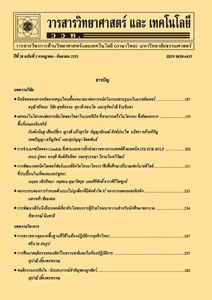อัตราการรอดและการเจริญเติบโตของกล้าไม้แสมขาว (Avicennia alba) ในดินตะกอนที่มีระยะห่างจากแนวชายฝั่งแตกต่างกัน
Main Article Content
Abstract
บทคัดย่อ
เมื่อตรวจวัดอัตราการรอด การเจริญเติบโต และการตอบสนองของกล้าไม้แสมขาว (Avicennia alba Bl.) ต่อสภาพแวดล้อมภายในดินตะกอน ภายในแปลงตัวอย่างที่มีลักษณะโครงสร้างของป่าชายเลนแตกต่างกัน จำนวน 3 แปลง ตามระยะห่างจากแนวชายฝั่งที่ 50, 100 และ 150 เมตร ตามลำดับ โดยศึกษาตั้งแต่เดือนกรกฎาคม 2554 ถึงเดือนมกราคม 2555 ในพื้นที่ชายฝั่งทะเลของจังหวัดชลบุรี แปลงตัวอย่างที่อยู่ใกล้ทะเลมากที่สุดซึ่งประกอบด้วยไม้อายุน้อยจะมีลักษณะของดินตะกอนที่มีปริมาณสารอินทรีย์ต่ำและมีค่าศักย์ไฟฟ้าในดินสูง ขณะที่ผืนป่าด้านในประกอบด้วยไม้ที่มีอายุมากขึ้นอยู่บนดินตะกอนที่มีปริมาณสารอินทรีย์สูง มีศักย์ไฟฟ้าต่ำ และมีค่าซัลไฟด์สูง ปริมาณความเข้มข้นของธาตุอาหารที่ตรวจวัดได้มีค่าสูง แสดงว่าในพื้นที่ดังกล่าวไม่ได้ขาดแคลนธาตุอาหาร ไม่ว่าจะเป็นไนโตรเจนหรือฟอสฟอรัส กล้าไม้ที่ขึ้นอยู่ในพื้นที่ใกล้ทะเลมากที่สุดจะมีอัตรารอดสูงกว่ากล้าไม้ที่ขึ้นอยู่ในผืนป่าด้านใน ความเค็มของน้ำระหว่างเม็ดดินมีค่าระหว่าง 6-29 ppt ซึ่งเป็นช่วงที่เหมาะสมต่อการเจริญเติบโตของไม้แสมขาว แต่การเพิ่มขึ้นของความเค็มตามฤดูกาลกลับส่งผลในทางลบต่ออัตราการรอดของกล้าไม้ นอกจากนี้การเปลี่ยนแปลงค่าศักย์ไฟฟ้าที่ลดต่ำลงประกอบกับมีค่าซัลไฟด์สูงขึ้นตามฤดูกาลภายในแปลงตัวอย่างทั้งสามส่งผลให้อัตราการรอดของกล้าไม้ลดต่ำลง และสัดส่วนมวลชีวภาพของกล้าไม้ที่กระจายไปสู่รากลดต่ำลงด้วย การศึกษานี้แสดงให้เห็นว่าความเค็ม ศักย์ไฟฟ้า และซัลไฟด์มีความสำคัญต่อการรอดตายของกล้าไม้แสมขาว
คำสำคัญ : ป่าชายเลน; แสมขาว; ศักย์ไฟฟ้า; ซัลไฟด์; ความเค็ม
Abstract
Survival and growth of Avicennia alba Bl. seedling to sedimentary environments among three different stands which related to distance of 50, 100 and 150 m from the coast were evaluated under field conditions from July 2011 to January 2012 at Chonburi coastal area, Thailand. Outermost sediments occupied by young stands consisted of low organic matter and displayed suboxic conditions with high redox potential (Eh). The development of forest structures to mature stages in landward zone stimulate accumulation of organic matter to sediment promoted low Eh values in consistent with high sulfide recorded. High nutrients concentrations were examined in porewater suggesting neither nitrogen nor phosphorus was deficit within the area. Seedling grew at the outermost plot showed higher survival rate compared to inner plots. Salinity in the area varied between 6-29 ppt and was appropriated to support growth of A. alba. However, seasonal change in salinity contributed to reduction of seedling survival rate. Eh and sediment sulfide content were also related to seedling survivorship between three different plots. Low Eh value in combination with high sulfide reduced the partitioning of root biomass. The present study indicated that salinity, Eh and sulfide were among the most important parameters contributing to seedling survivorship.
Keywords: mangrove; Avicennia alba; redox potential; sulfide; salinity


